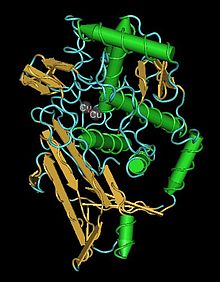Hemocyanin
| Hemocyanin, copper containing domain | |||||||||
|---|---|---|---|---|---|---|---|---|---|

Single Oxygenated Functional Unit from the hemocyanin of an octopus
|
|||||||||
| Identifiers | |||||||||
| Symbol | Hemocyanin_M | ||||||||
| Pfam | PF00372 | ||||||||
| InterPro | IPR000896 | ||||||||
| PROSITE | PDOC00184 | ||||||||
| SCOP | 1lla | ||||||||
| SUPERFAMILY | 1lla | ||||||||
|
|||||||||
| Available protein structures: | |
|---|---|
| Pfam | structures |
| PDB | RCSB PDB; PDBe; PDBj |
| PDBsum | structure summary |
| Hemocyanin, all-alpha domain | |||||||||
|---|---|---|---|---|---|---|---|---|---|

Crystal structure of hexameric haemocyanin from Panulirus interruptus refined at 3.2 angstroms resolution
|
|||||||||
| Identifiers | |||||||||
| Symbol | Hemocyanin_N | ||||||||
| Pfam | PF03722 | ||||||||
| InterPro | IPR005204 | ||||||||
| PROSITE | PDOC00184 | ||||||||
| SCOP | 1lla | ||||||||
| SUPERFAMILY | 1lla | ||||||||
|
|||||||||
| Available protein structures: | |
|---|---|
| Pfam | structures |
| PDB | RCSB PDB; PDBe; PDBj |
| PDBsum | structure summary |
| Hemocyanin, ig-like domain | |||||||||
|---|---|---|---|---|---|---|---|---|---|

crystallographic analysis of oxygenated and deoxygenated states of arthropod hemocyanin shows unusual differences
|
|||||||||
| Identifiers | |||||||||
| Symbol | Hemocyanin_C | ||||||||
| Pfam | PF03723 | ||||||||
| InterPro | IPR005203 | ||||||||
| PROSITE | PDOC00184 | ||||||||
| SCOP | 1lla | ||||||||
| SUPERFAMILY | 1lla | ||||||||
|
|||||||||
| Available protein structures: | |
|---|---|
| Pfam | structures |
| PDB | RCSB PDB; PDBe; PDBj |
| PDBsum | structure summary |
Hemocyanins (also spelled haemocyanins and abbreviated Hc) are proteins that transport oxygen throughout the bodies of some invertebrate animals. These metalloproteins contain two copper atoms that reversibly bind a single oxygen molecule (O2). They are second only to hemoglobin in frequency of use as an oxygen transport molecule. Unlike the hemoglobin in red blood cells found in vertebrates, hemocyanins are not bound to blood cells but are instead suspended directly in the hemolymph. Oxygenation causes a color change between the colorless Cu(I) deoxygenated form and the blue Cu(II) oxygenated form.
Hemocyanins are found only in the Mollusca and Arthropoda: the earliest hemocyanins were found in the snail Helix pomatia (a mollusc) and in the horseshoe crab (an arthropod). They were subsequently found to be common among crustaceans and are utilized by some land arthropods such as the tarantula Eurypelma californicum, the emperor scorpion, and the centipede Scutigera coleoptrata. Also, larval storage proteins in many insects appear to be derived from hemocyanins.
The arthropod hemocyanin superfamily is composed of phenoloxidases, hexamerins, pseudohemocyanins or cryptocyanins, (dipteran) hexamerin receptors.
Phenoloxidase are copper containing tyrosinases. These proteins are involved in the process of sclerotization of arthropod cuticle, in wound healing, and humoral immune defense. Phenoloxidase is synthesized by zymogens and are activated by cleaving a N-terminal peptide.
Hexamerins are storage proteins commonly found in insects. These proteins are synthesized by the larval fat body and are associated with molting cycles or nutritional conditions.
...
Wikipedia
